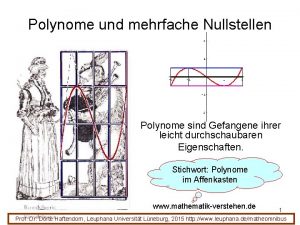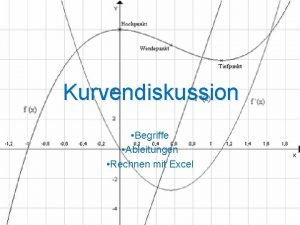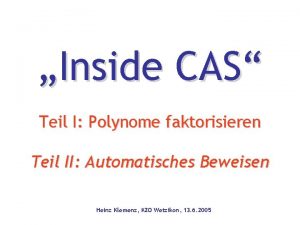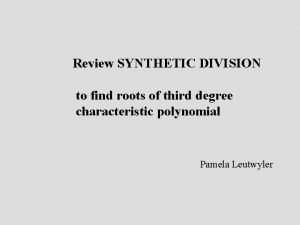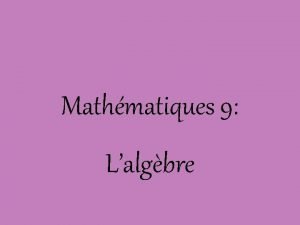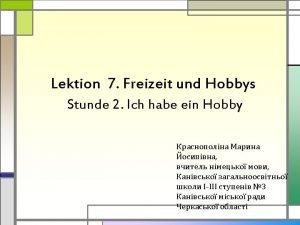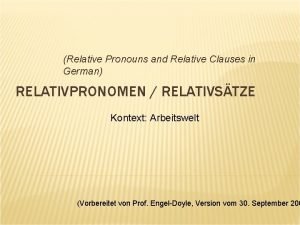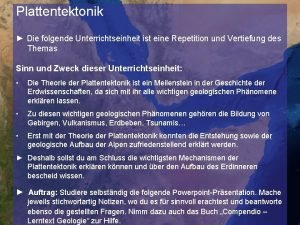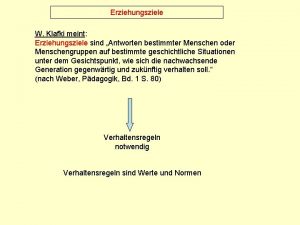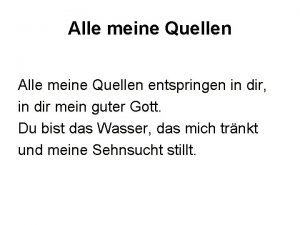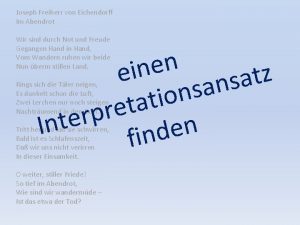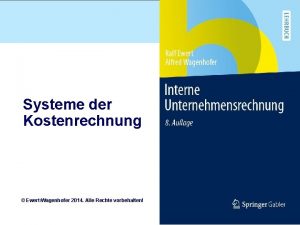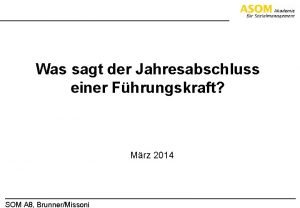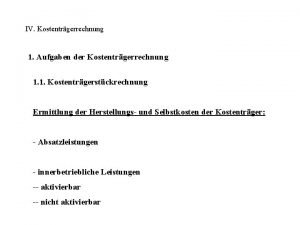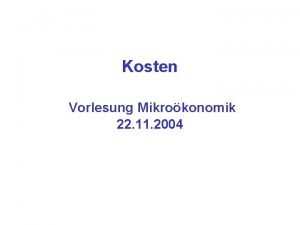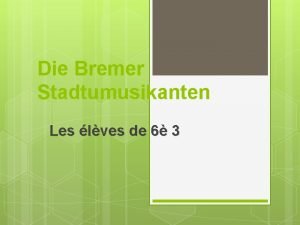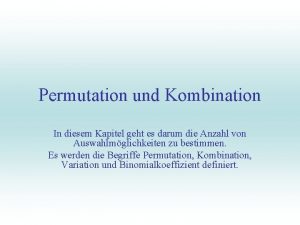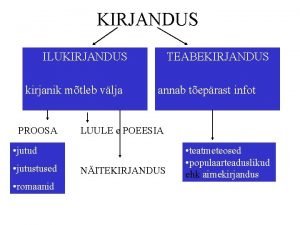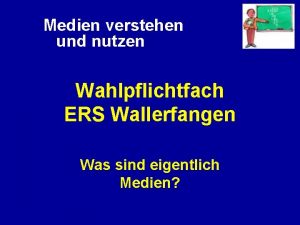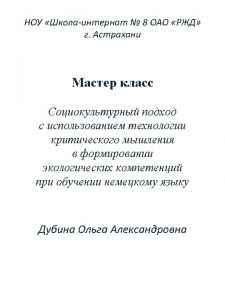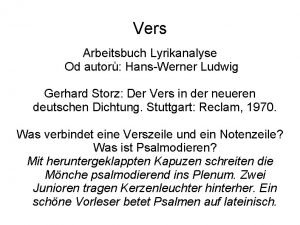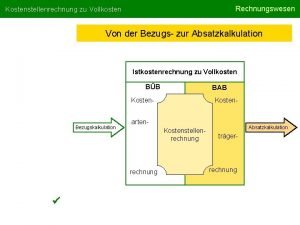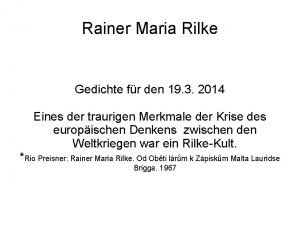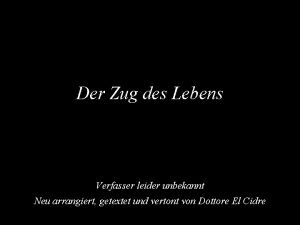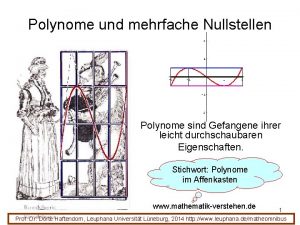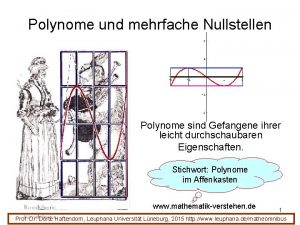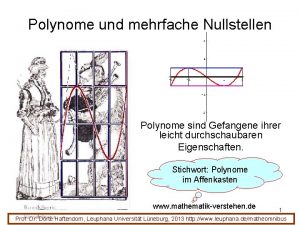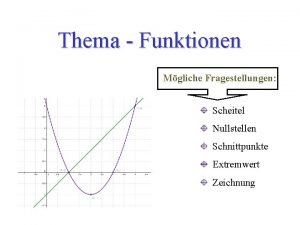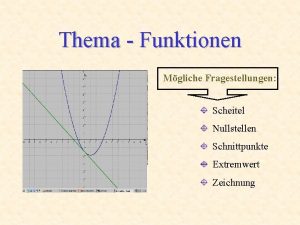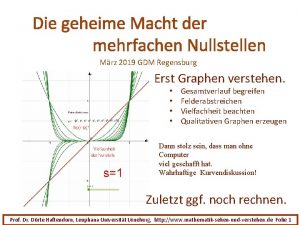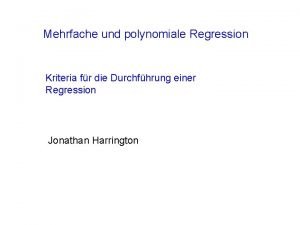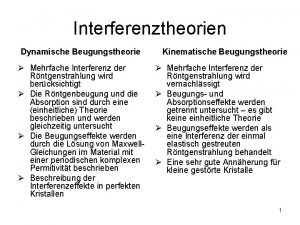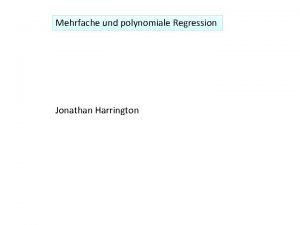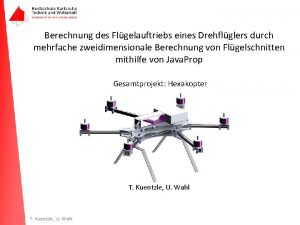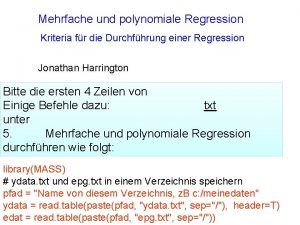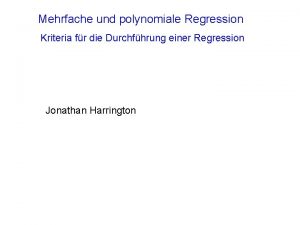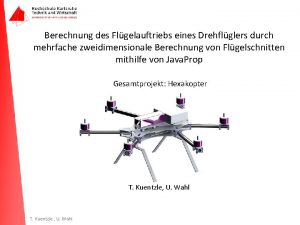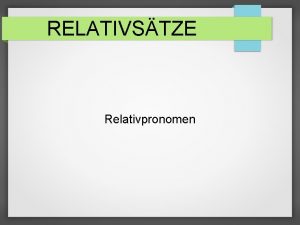Polynome und mehrfache Nullstellen Polynome sind Gefangene ihrer
































































- Slides: 64

Polynome und mehrfache Nullstellen Polynome sind Gefangene ihrer leicht durchschaubaren Eigenschaften. Stichwort: Polynome im Affenkasten www. mathematik-verstehen. de 1 Prof. Dr. Dörte Haftendorn, Leuphana Universität Lüneburg, 2013 http: //www. leuphana. de/matheomnibus

Polynomials and Multiple Zeros polynomials are prisons of their obvious characteristics These are named: polynomials in an „arp box“ key word: Polynome im Affenkasten www. mathematik-verstehen. de 2 Prof. Dr. Dörte Haftendorn, Leuphana Universität Lüneburg, 2013 http: //www. leuphana. de/matheomnibus

Polynome und mehrfache Nullstellen gerade schräg www. mathematik-verstehen. de 3 Prof. Dr. Dörte Haftendorn, Leuphana Universität Lüneburg, 2013 http: //www. leuphana. de/matheomnibus

Polynomials and Multiple Zeros gerade schräg www. mathematik-verstehen. de 4 Prof. Dr. Dörte Haftendorn, Leuphana Universität Lüneburg, 2013 http: //www. leuphana. de/matheomnibus

Nullstellen Linearfaktoren double zero single zero x= -1 x= 2 5 Prof. Dr. Dörte Haftendorn, Leuphana Universität Lüneburg, 2013 http: //www. leuphana. de/matheomnibus

Zeros Linear Factors doppelte Nullstelle einfache Nullstelle x= -1 x= 2 6 Prof. Dr. Dörte Haftendorn, Leuphana Universität Lüneburg, 2013 http: //www. leuphana. de/matheomnibus

Nullstellen Linearfaktoren doppelte Nullstelle einfache Nullstelle x= -1 x= 2 7 Prof. Dr. Dörte Haftendorn, Leuphana Universität Lüneburg, 2013 http: //www. leuphana. de/matheomnibus

Zeros Linear Factors double zero single zero x= -1 x= 2 8 Prof. Dr. Dörte Haftendorn, Leuphana Universität Lüneburg, 2013 http: //www. leuphana. de/matheomnibus

Welche Gleichung kann dieses Polynom haben? 9 Prof. Dr. Dörte Haftendorn, Leuphana Universität Lüneburg, 2013 http: //www. leuphana. de/matheomnibus

Which Equation ist Possible for this Polynomial? 10 Prof. Dr. Dörte Haftendorn, Leuphana Universität Lüneburg, 2013 http: //www. leuphana. de/matheomnibus

Welche Gleichung kann dieses Polynom haben? Diese Funktion Vieta, mehr 11 Prof. Dr. Dörte Haftendorn, Leuphana Universität Lüneburg, 2013 http: //www. leuphana. de/matheomnibus

Which Equation ist Possible for this Polynomial? this function Vieta, plus 12 Prof. Dr. Dörte Haftendorn, Leuphana Universität Lüneburg, 2013 http: //www. leuphana. de/matheomnibus

Was ist eigentlich ein Polynom? Ein Polynom ist eine Summe von Potenzfunktionen. Der höchste Exponent, der vorkommt, heißt Grad des Polynoms. • Polynome 1. Grades sind die Geraden • Polynome 2. Grades sind die Parabeln • Polynome 3. Grades haben immer eine symmetrische s-Form. • Polynome 4. Grades haben höchstens 3 Extrema. • Je höher der Grad, desto vielfältigere Formen sind möglich. 13 Prof. Dr. Dörte Haftendorn, Leuphana Universität Lüneburg, 2013 http: //www. leuphana. de/matheomnibus

How is a Polynomial Defined? A polynomial is a sum of power functions. The highest exponent is named degree of the polynomial. • Polynomials of degree 1 are the straight lines. • Polynomials of degree 2 are the parabolas. • Polynomials of degree always have a symmetrical s-Form. • Polynomials of degree 4 have at most 3 extrema. • The higher the degree the manifold forms are possible. 14 Prof. Dr. Dörte Haftendorn, Leuphana Universität Lüneburg, 2013 http: //www. leuphana. de/matheomnibus

Polynome und ihre Linearfaktoren Jede reelle Nullstelle erzeugt einen Linearfaktor. Wenn das Restpolynom auch noch die Nullstelle enthält, kann man den Linearfaktor mehrfach „herausziehen“. Geht das maximal k-mal, dann heißt oder „Nullstelle der Vielfachheit k“ k-fache Nullstelle, 15 Prof. Dr. Dörte Haftendorn, Leuphana Universität Lüneburg, 2013 http: //www. leuphana. de/matheomnibus

Polynomials and their Linear Factors Every real zero corresponds to a linear factor. If the remaining polynomial has zero too, you can „pull out“ the linear factor twice ore more. is named zero of degree k, if this is possible k times at most, An othe name ist „zero of the order k“. 16 Prof. Dr. Dörte Haftendorn, Leuphana Universität Lüneburg, 2013 http: //www. leuphana. de/matheomnibus

Polynome und ihre Linearfaktoren In der Nähe eine k-fachen Nullstelle verhält sich das Polynom wie sich die k-Potenzfunktion im Ursprung verhält. Grad 10 Gesamtverlauf Ein Polynom n-ten Grades hat höchsten n Nullstellen, mit ihrer Vielfachheit gezählt. Fundamentalsatz der Algebra (reell) 17 Prof. Dr. Dörte Haftendorn, Leuphana Universität Lüneburg, 2013 http: //www. leuphana. de/matheomnibus

Polynomials and their Linear Factors The polynomial is in the neighbourhood of k-order zero similar to a power function of degree k near the origin. degree 10 outside form A polynomial of degree n has at most n zeros, counted with their orders. fundamental theorem of algebra (real version) 18 Prof. Dr. Dörte Haftendorn, Leuphana Universität Lüneburg, 2013 http: //www. leuphana. de/matheomnibus

Polynome und ihre Linearfaktoren Qualitativer Graph eines durch Linearfaktoren gegeben Polynoms Vorzeichen Grad Ges. Verlauf gerade ungerade 19 Prof. Dr. Dörte Haftendorn, Leuphana Universität Lüneburg, 2013 http: //www. leuphana. de/matheomnibus

Polynomials and their Linear Factors Qualitative Graph of a polynomial, given with its linear factors. sign degree outer form even odd 20 Prof. Dr. Dörte Haftendorn, Leuphana Universität Lüneburg, 2013 http: //www. leuphana. de/matheomnibus

Übung 2 mit Polynomen 21 Prof. Dr. Dörte Haftendorn, Leuphana Universität Lüneburg, 2013 http: //www. leuphana. de/matheomnibus

Practice 2 with Polynomials 22 Prof. Dr. Dörte Haftendorn, Leuphana Universität Lüneburg, 2013 http: //www. leuphana. de/matheomnibus

Übung 2 mit Polynomen 23 Prof. Dr. Dörte Haftendorn, Leuphana Universität Lüneburg, 2013 http: //www. leuphana. de/matheomnibus

Practice 2 with Polynomials 24 Prof. Dr. Dörte Haftendorn, Leuphana Universität Lüneburg, 2013 http: //www. leuphana. de/matheomnibus

Übung 3 mit Polynomen 25 Prof. Dr. Dörte Haftendorn, Leuphana Universität Lüneburg, 2013 http: //www. leuphana. de/matheomnibus

Practice 3 with Polynomials 26 Prof. Dr. Dörte Haftendorn, Leuphana Universität Lüneburg, 2013 http: //www. leuphana. de/matheomnibus

Übung 3 mit Polynomen 27 Prof. Dr. Dörte Haftendorn, Leuphana Universität Lüneburg, 2013 http: //www. leuphana. de/matheomnibus

Practice 3 with Polynomials 28 Prof. Dr. Dörte Haftendorn, Leuphana Universität Lüneburg, 2013 http: //www. leuphana. de/matheomnibus

Übung 4 mit Polynomen 29 Prof. Dr. Dörte Haftendorn, Leuphana Universität Lüneburg, 2013 http: //www. leuphana. de/matheomnibus

Practice 4 with Polynomials 30 Prof. Dr. Dörte Haftendorn, Leuphana Universität Lüneburg, 2013 http: //www. leuphana. de/matheomnibus

Übung 4 mit Polynomen 31 Prof. Dr. Dörte Haftendorn, Leuphana Universität Lüneburg, 2013 http: //www. leuphana. de/matheomnibus

Practice 4 with Polynomials 32 Prof. Dr. Dörte Haftendorn, Leuphana Universität Lüneburg, 2013 http: //www. leuphana. de/matheomnibus

Funktionen als zentrales Werkzeug • Potenzfunktionen • Polynome • Trigonometrische Funktionen Da sw ar • Exponentialfunktionen • Davon so manche Umkehrfunktionen ‘s da n n ab er au ch • Wurzelfunktionen • Arkusfunktionen • Logarithmusfunktionen Und das noch koppeln mit und Verkettung. 33 Prof. Dr. Dörte Haftendorn, Leuphana Universität Lüneburg, 2013 http: //www. leuphana. de/matheomnibus

Functions as a Central Tool • power functions • polynomials • trigonometric functions • exponential functions • some inverse functions • root functions th at ‘s al l fo rn or m al pu rp o se • arc functions • logarithmic functions and at that you can caculate and build chains. 34 Prof. Dr. Dörte Haftendorn, Leuphana Universität Lüneburg, 2013 http: //www. leuphana. de/matheomnibus

Funktionen als zentrales Werkzeug Sinusfunktion 35 Prof. Dr. Dörte Haftendorn, Leuphana Universität Lüneburg, 2013 http: //www. leuphana. de/matheomnibus

Functions as a Central Tool sine function 36 Prof. Dr. Dörte Haftendorn, Leuphana Universität Lüneburg, 2013 http: //www. leuphana. de/matheomnibus

Die Winkel-Funktionen Der Punkt Q läuft im Einheitskreis vom Start (1/0). (mathematisch positiv = gegen die Uhr) Den von Q zurückgelegten Weg x nennt man auch „das Bogenmaß des Winkels“, um den sich Q gedreht hat. Kurz: x ist der Winkel im Bogenmaß Einheitskreis x wird Argument einer Funktion 37 Prof. Dr. Dörte Haftendorn, Leuphana Universität Lüneburg, 2013 http: //www. leuphana. de/matheomnibus

Angle Functions Point Q goes in the unit circle with start in (1/0). (mathematical positiv = against the clock) The distance x, covered by Q on the circle, ist named „the radian measure of the angle“, the angle of rotation of Q. short: x is the angle in radian measure unit circle x becomes argument of a function 38 Prof. Dr. Dörte Haftendorn, Leuphana Universität Lüneburg, 2013 http: //www. leuphana. de/matheomnibus

Die Sinus-Funktion Dem Winkel x wird nun die Ordinate von Q zugeordnet. Die Funktion, die das leistet, heißt Sinus-Funktion. Einheitskreis x = Winkel im Bogenmaß = Länge des Bogens im Einheitskreis Sinusfunktion 39 Prof. Dr. Dörte Haftendorn, Leuphana Universität Lüneburg, 2013 http: //www. leuphana. de/matheomnibus

Sine Function The angle x correlates with the ordinate of Q. The function, which is able to do do, is the sine-function. unit circle x = angle in radian measure = distance of the arc in the unit circle sine function 40 Prof. Dr. Dörte Haftendorn, Leuphana Universität Lüneburg, 2013 http: //www. leuphana. de/matheomnibus

Die Sinus-Funktion Einheitskreis x = Winkel im Bogenmaß = Länge des Bogens im Einheitskreis Sinusfunktion 41 Prof. Dr. Dörte Haftendorn, Leuphana Universität Lüneburg, 2013 http: //www. leuphana. de/matheomnibus

Sine Function unit circle x = angle in radian measure = distance of the arc in the unit circle sine function 42 Prof. Dr. Dörte Haftendorn, Leuphana Universität Lüneburg, 2013 http: //www. leuphana. de/matheomnibus

Eigenschaften der Sinus-Funktion • Die Sinus-Funktion ist periodisch. • Die Periode ist . • Die Sinuswerte liegen zwischen -1 und + 1. • Die Sinusbögen sind symmetrisch. • Die Sinuskurve ist punktsymmetrisch zum Ursprung 43 Prof. Dr. Dörte Haftendorn, Leuphana Universität Lüneburg, 2013 http: //www. leuphana. de/matheomnibus

Properties of the Sine Function • The sine function is periodic. • The period is . • The sine ordinates are between -1 and + 1. • The arcs of the sine function are symmetric. • The sine curve has the origin as a point of symmetry. 44 Prof. Dr. Dörte Haftendorn, Leuphana Universität Lüneburg, 2013 http: //www. leuphana. de/matheomnibus

Die Sinus-Funktion Dem Winkel x wird nun die Ordinate von Q zugeordnet. Die Funktion, die das leistet, heißt Sinus-Funktion. Einheitskreis x = Winkel im Bogenmaß = Länge des Bogens im Einheitskreis Sinusfunktion 45 Prof. Dr. Dörte Haftendorn, Leuphana Universität Lüneburg, 2013 http: //www. leuphana. de/matheomnibus

Sine Function The angle x correlates with the ordinate of Q. The function, which is able to do do, is the sine function. unit circle x = angle in radian measure = distance of the arc in the unit circle sine function 46 Prof. Dr. Dörte Haftendorn, Leuphana Universität Lüneburg, 2013 http: //www. leuphana. de/matheomnibus

Die Kosinus-Funktion Dem Winkel x wird nun die Ordinate von Q zugeordnet. Die Funktion, die das leistet, heißt Sinus-Funktion. Einheitskreis x = Winkel im Bogenmaß = Länge des Bogens im Einheitskreis Tangens Kosinus Sinusfunktion 47 Prof. Dr. Dörte Haftendorn, Leuphana Universität Lüneburg, 2013 http: //www. leuphana. de/matheomnibus

Cosine Function abscissa The angle x correlates with the ordinate of Q. The function, which is able to do do, is the sine cosine function. unit circle x = angle in radian measure = distance of the arc in the unit circle cosine function 48 Prof. Dr. Dörte Haftendorn, Leuphana Universität Lüneburg, 2013 http: //www. leuphana. de/matheomnibus

Eigenschaften der Kosinus-Funktion • Die Kosinus-Funktion ist periodisch. • Die Periode ist . • Die Kosinuswerte liegen zwischen -1 und + 1. • Die Kosinusbögen sind symmetrisch. • Die Kosinuskurve ist symmetrisch zur y-Achse 49 Prof. Dr. Dörte Haftendorn, Leuphana Universität Lüneburg, 2013 http: //www. leuphana. de/matheomnibus

Properties of the Cosine Function • The cosine function is periodic. • The period is . • The ordinates of the cosine are between -1 and + 1. • The arcs of the cosine sind symmetrisch. • The cosine curve is symmetric to the y-axis 50 Prof. Dr. Dörte Haftendorn, Leuphana Universität Lüneburg, 2013 http: //www. leuphana. de/matheomnibus

Sinus strecken und stauchen 51 Prof. Dr. Dörte Haftendorn, Leuphana Universität Lüneburg, 2013 http: //www. leuphana. de/matheomnibus

To Stretch and Compress the Sine Function 52 Prof. Dr. Dörte Haftendorn, Leuphana Universität Lüneburg, 2013 http: //www. leuphana. de/matheomnibus

Funktionen strecken und stauchen Ein Faktor direkt beim x sorgt für waagerechtes Strecken und Stauchen. 53 Prof. Dr. Dörte Haftendorn, Leuphana Universität Lüneburg, 2013 http: //www. leuphana. de/matheomnibus

To Stretch and Compress the Functions to stretch and compress in the direction of the x-axis you must put a factor to x directly 54 Prof. Dr. Dörte Haftendorn, Leuphana Universität Lüneburg, 2013 http: //www. leuphana. de/matheomnibus

Funktionen strecken und stauchen 55 Prof. Dr. Dörte Haftendorn, Leuphana Universität Lüneburg, 2013 http: //www. leuphana. de/matheomnibus

To Stretch and Compress the Functions 56 Prof. Dr. Dörte Haftendorn, Leuphana Universität Lüneburg, 2013 http: //www. leuphana. de/matheomnibus

Fkt-Vari-Sin Funktionen variieren Sin-Ueb 57 Prof. Dr. Dörte Haftendorn, Leuphana Universität Lüneburg, 2013 http: //www. leuphana. de/matheomnibus

Fkt-Vari-Sin Variation of Functions Sin-Ueb 58 Prof. Dr. Dörte Haftendorn, Leuphana Universität Lüneburg, 2013 http: //www. leuphana. de/matheomnibus

Fkt-Vari-Sin Funktionen variieren Sin-Ueb 59 Prof. Dr. Dörte Haftendorn, Leuphana Universität Lüneburg, 2013 http: //www. leuphana. de/matheomnibus

Fkt-Vari-Sin Variation of Functions Sin-Ueb 60 Prof. Dr. Dörte Haftendorn, Leuphana Universität Lüneburg, 2013 http: //www. leuphana. de/matheomnibus

Übung mit Funktionsgraphen Sin-Ueb 61 Prof. Dr. Dörte Haftendorn, Leuphana Universität Lüneburg, 2013 http: //www. leuphana. de/matheomnibus

How to Sketch Sine and Cosine Function Sin-Ueb 62 Prof. Dr. Dörte Haftendorn, Leuphana Universität Lüneburg, 2013 http: //www. leuphana. de/matheomnibus

Welle, wave 63 Prof. Dr. Dörte Haftendorn, Leuphana Universität Lüneburg, 2013 http: //www. leuphana. de/matheomnibus

Übung mit Funktionsgraphen 64 Prof. Dr. Dörte Haftendorn, Leuphana Universität Lüneburg, 2013 http: //www. leuphana. de/matheomnibus
 Linearfaktoren mehrfache nullstellen
Linearfaktoren mehrfache nullstellen Linearfaktoren mehrfache nullstellen
Linearfaktoren mehrfache nullstellen Zu ihrer hochzeit fand das erste oktoberfest statt
Zu ihrer hochzeit fand das erste oktoberfest statt Ich bin du bist er ist wir sind ihr seid
Ich bin du bist er ist wir sind ihr seid Ich bin du bist er sie es ist wir sind ihr seid sie sind
Ich bin du bist er sie es ist wir sind ihr seid sie sind Viele sind berufen aber wenige sind auserwählt
Viele sind berufen aber wenige sind auserwählt Excel nullstellen berechnen
Excel nullstellen berechnen Berlekamp algorithmus
Berlekamp algorithmus Polynome caractéristique
Polynome caractéristique Monôme exemple
Monôme exemple Meine hobbys sind musik hören
Meine hobbys sind musik hören Alle hatten die hosen voll nur bei mir liefs flüssig
Alle hatten die hosen voll nur bei mir liefs flüssig Peter hinnen mir sind mit em velo da
Peter hinnen mir sind mit em velo da Wieviel km sind 1 km luftlinie
Wieviel km sind 1 km luftlinie Wo sind die kinderrechte aufgeschrieben
Wo sind die kinderrechte aufgeschrieben Das alles ist deutschland das alles sind wir
Das alles ist deutschland das alles sind wir Sprachliche mittel die physiker
Sprachliche mittel die physiker Wie fragt man nach der adverbialen bestimmung des ortes
Wie fragt man nach der adverbialen bestimmung des ortes Ich habe viele hobbys
Ich habe viele hobbys Was sind grundrechte
Was sind grundrechte Was sind indikatoren
Was sind indikatoren Relative clauses in german
Relative clauses in german Was ist ein gleichnis
Was ist ein gleichnis Ist der wal ein fisch
Ist der wal ein fisch Was ist eine transformstörung
Was ist eine transformstörung Wir sind nicht mehr was wir mal waren
Wir sind nicht mehr was wir mal waren Beta naphtholorange verwendung
Beta naphtholorange verwendung Substantiv
Substantiv Leitziel richtziel, grobziel feinziel beispiele
Leitziel richtziel, grobziel feinziel beispiele Was sind push und pull faktoren
Was sind push und pull faktoren Auch dornteufel genannte australische echse
Auch dornteufel genannte australische echse Was sind ihre beruflichen ziele
Was sind ihre beruflichen ziele Alle meine quellen entspringen in dir noten mehrstimmig
Alle meine quellen entspringen in dir noten mehrstimmig Abendrot eichendorff analyse
Abendrot eichendorff analyse Prozesskostenrechnung
Prozesskostenrechnung Drei dinge sind uns aus dem paradies geblieben
Drei dinge sind uns aus dem paradies geblieben Sind rückstellungen fremdkapital
Sind rückstellungen fremdkapital Daten sind das neue gold
Daten sind das neue gold Du machst mich immer noch verrückt nach all jahren
Du machst mich immer noch verrückt nach all jahren Werte
Werte Formelle gruppe
Formelle gruppe Vorwärtskalkulation aufgaben
Vorwärtskalkulation aufgaben Was sind grenzkosten
Was sind grenzkosten Relative clauses examples
Relative clauses examples Wir sind die wohlbekannten lustigen bremer stadtmusikanten
Wir sind die wohlbekannten lustigen bremer stadtmusikanten Die ferien sind vorbei
Die ferien sind vorbei Was sind vielfache
Was sind vielfache Wie viele wörter sind das
Wie viele wörter sind das Anneli kanarik
Anneli kanarik Was sind verben
Was sind verben Wo sind die nordalpen
Wo sind die nordalpen Ers wallerfangen
Ers wallerfangen Osterspaziergang vom eise befreit
Osterspaziergang vom eise befreit Gedicht aufbau
Gedicht aufbau Funktionsspiel
Funktionsspiel Sachtexte arten
Sachtexte arten Ressourcen beispiele
Ressourcen beispiele Der zug des lebens geschichte
Der zug des lebens geschichte Was sind gemeinkosten
Was sind gemeinkosten Was sind qualifizierungsbausteine
Was sind qualifizierungsbausteine Der tod ist groß wir sind die seinen interpretation
Der tod ist groß wir sind die seinen interpretation Merkmale von gedichten klasse 6
Merkmale von gedichten klasse 6 Was sind cousins 2 grades
Was sind cousins 2 grades Das leben ist wie eine reise im zug der zug des lebens text
Das leben ist wie eine reise im zug der zug des lebens text Wir sind wie schneeflocken
Wir sind wie schneeflocken
